上海交通大学:《台湾研究》课程教学资源(英文PPT课件)09-10 U.S.-Taiwan Relations
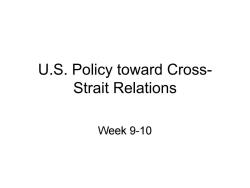
U.S.Policy toward Cross- Strait Relations Week 9-10
U.S. Policy toward Cross- Strait Relations Week 9-10
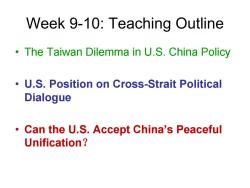
Week 9-10:Teaching Outline The Taiwan Dilemma in U.S.China Policy U.S.Position on Cross-Strait Political Dialogue Can the U.S.Accept China's Peaceful Unification?
Week 9-10: Teaching Outline • The Taiwan Dilemma in U.S. China Policy • U.S. Position on Cross-Strait Political Dialogue • Can the U.S. Accept China’s Peaceful Unification?

1.The Taiwan Dilemma in U.S.China Policy Strategic interest vs.ideological consideration Which one (side)is more important? ·The Nixon phenomenon ·Vill vs.capability
1. The Taiwan Dilemma in U.S. China Policy • Strategic interest vs. ideological consideration • Which one (side) is more important? • The Nixon phenomenon • Will vs. capability
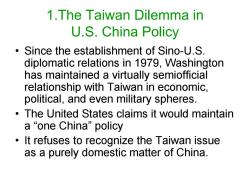
1.The Taiwan Dilemma in U.S.China Policy Since the establishment of Sino-U.S. diplomatic relations in 1979,Washington has maintained a virtually semiofficial relationship with Taiwan in economic, political,and even military spheres. The United States claims it would maintain a“one China”policy It refuses to recognize the Taiwan issue as a purely domestic matter of China
1.The Taiwan Dilemma in U.S. China Policy • Since the establishment of Sino-U.S. diplomatic relations in 1979, Washington has maintained a virtually semiofficial relationship with Taiwan in economic, political, and even military spheres. • The United States claims it would maintain a “one China” policy • It refuses to recognize the Taiwan issue as a purely domestic matter of China
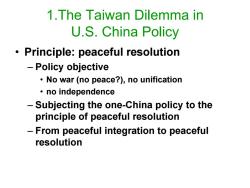
1.The Taiwan Dilemma in U.S.China Policy Principle:peaceful resolution Policy objective No war (no peace?),no unification ·no independence Subjecting the one-China policy to the principle of peaceful resolution From peaceful integration to peaceful resolution
1.The Taiwan Dilemma in U.S. China Policy • Principle: peaceful resolution – Policy objective • No war (no peace?), no unification • no independence – Subjecting the one-China policy to the principle of peaceful resolution – From peaceful integration to peaceful resolution
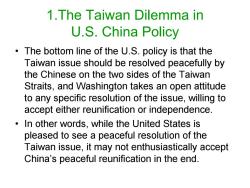
1.The Taiwan Dilemma in U.S.China Policy The bottom line of the U.S.policy is that the Taiwan issue should be resolved peacefully by the Chinese on the two sides of the Taiwan Straits,and Washington takes an open attitude to any specific resolution of the issue,willing to accept either reunification or independence. In other words,while the United States is pleased to see a peaceful resolution of the Taiwan issue,it may not enthusiastically accept China's peaceful reunification in the end
1.The Taiwan Dilemma in U.S. China Policy • The bottom line of the U.S. policy is that the Taiwan issue should be resolved peacefully by the Chinese on the two sides of the Taiwan Straits, and Washington takes an open attitude to any specific resolution of the issue, willing to accept either reunification or independence. • In other words, while the United States is pleased to see a peaceful resolution of the Taiwan issue, it may not enthusiastically accept China’s peaceful reunification in the end
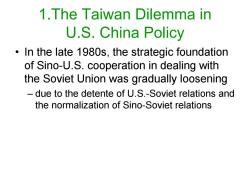
1.The Taiwan Dilemma in U.S.China Policy In the late 1980s,the strategic foundation of Sino-U.S.cooperation in dealing with the Soviet Union was gradually loosening due to the detente of U.S.-Soviet relations and the normalization of Sino-Soviet relations
1.The Taiwan Dilemma in U.S. China Policy • In the late 1980s, the strategic foundation of Sino-U.S. cooperation in dealing with the Soviet Union was gradually loosening – due to the detente of U.S.-Soviet relations and the normalization of Sino-Soviet relations
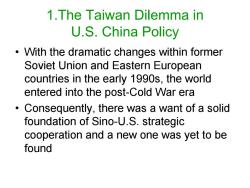
1.The Taiwan Dilemma in U.S.China Policy With the dramatic changes within former Soviet Union and Eastern European countries in the early 1990s,the world entered into the post-Cold War era Consequently,there was a want of a solid foundation of Sino-U.S.strategic cooperation and a new one was yet to be found
1.The Taiwan Dilemma in U.S. China Policy • With the dramatic changes within former Soviet Union and Eastern European countries in the early 1990s, the world entered into the post-Cold War era • Consequently, there was a want of a solid foundation of Sino-U.S. strategic cooperation and a new one was yet to be found
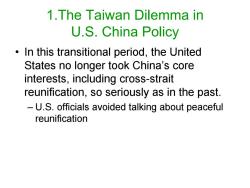
1.The Taiwan Dilemma in U.S.China Policy In this transitional period,the United States no longer took China's core interests,including cross-strait reunification,so seriously as in the past. -U.S.officials avoided talking about peaceful reunification
1.The Taiwan Dilemma in U.S. China Policy • In this transitional period, the United States no longer took China’s core interests, including cross-strait reunification, so seriously as in the past. – U.S. officials avoided talking about peaceful reunification
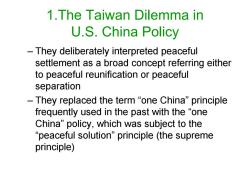
1.The Taiwan Dilemma in U.S.China Policy They deliberately interpreted peaceful settlement as a broad concept referring either to peaceful reunification or peaceful separation -They replaced the term“one China”principle frequently used in the past with the "one China"policy,which was subject to the “peaceful solution”principle(the supreme principle)
1.The Taiwan Dilemma in U.S. China Policy – They deliberately interpreted peaceful settlement as a broad concept referring either to peaceful reunification or peaceful separation – They replaced the term “one China” principle frequently used in the past with the “one China” policy, which was subject to the “peaceful solution” principle (the supreme principle)
按次数下载不扣除下载券;
注册用户24小时内重复下载只扣除一次;
顺序:VIP每日次数-->可用次数-->下载券;
- 上海交通大学:《台湾研究》课程教学资源(英文PPT课件)08 Civic Exchange across the Taiwan Strait.ppt
- 上海交通大学:《台湾研究》课程教学资源(英文PPT课件)07 Political Interaction across the Taiwan Strait.pptx
- 上海交通大学:《台湾研究》课程教学资源(英文PPT课件)06 Politics of Identity.pptx
- 上海交通大学:《台湾研究》课程教学资源(英文PPT课件)05 Taiwan's Party System short.ppt
- 上海交通大学:《台湾研究》课程教学资源(英文PPT课件)04 Party Politics in Taiwan short.ppt
- 上海交通大学:《台湾研究》课程教学资源(英文PPT课件)03 Conditions and Process of Taiwan's Democratization short.ppt
- 上海交通大学:《台湾研究》课程教学资源(英文PPT课件)02 Historical Roots of the Taiwan Issue short.ppt
- 上海交通大学:《台湾研究》课程教学资源(英文PPT课件)01 Introduction short.ppt
- 上海交通大学:《当代中国外交》课程教学资源_Lesson 9_问题讨论_lesson 9 问题讨论.docx
- 上海交通大学:《当代中国外交》课程教学资源_Lesson 9_中文阅读材料_结构失衡_中苏同盟破裂的深层原因.pdf
- 上海交通大学:《当代中国外交》课程教学资源_Lesson 9_中文阅读材料_张曙光著_经济冷战_美国对华经济禁运和中苏同盟.pdf
- 上海交通大学:《当代中国外交》课程教学资源_Lesson 9_中文阅读材料_中苏关系破裂原因_研究述评.pdf
- 上海交通大学:《当代中国外交》课程教学资源_Lesson 9_中文阅读材料_50年代末至60年代中苏关系恶化的战略_理论与利益背景.pdf
- 上海交通大学:《当代中国外交》课程教学资源_Lesson 8_问题讨论_lesson 8 问题讨论.docx
- 上海交通大学:《当代中国外交》课程教学资源_Lesson 8_中文阅读材料_中苏在援越抗美问题上的冲突与矛盾_1965_1972_下.pdf
- 上海交通大学:《当代中国外交》课程教学资源_Lesson 8_中文阅读材料_中苏在援越抗美问题上的冲突与矛盾_1965_1972_上.pdf
- 上海交通大学:《当代中国外交》课程教学资源_Lesson 8_中文阅读材料_抗美援朝_与_援越抗美_中国如何应对朝鲜战争和越南战争_章百家.pdf
- 上海交通大学:《当代中国外交》课程教学资源_Lesson 7_问题讨论_lesson 7 问题讨论.docx
- 上海交通大学:《当代中国外交》课程教学资源_Lesson 7_中文阅读材料_难以弥合的裂痕_苏联对中印冲突的立场及中苏分歧公开化_1959_1960.pdf
- 上海交通大学:《当代中国外交》课程教学资源_Lesson 7_中文阅读材料_关于1962年中印边界冲突和中苏分裂研究的若干问题.pdf
- 上海交通大学:《台湾研究》课程教学资源(英文PPT课件)11 Prospects of Cross-Strait Relations short.ppt
- 上海交通大学:《台湾研究》课程教学资源_China's National Identity under Reconstruction.docx
- 上海交通大学:《台湾研究》课程教学资源_Party Politics.docx
- 上海交通大学:《台湾研究》课程教学资源_再论台湾两党体系的可延续.pdf
- 上海交通大学:《台湾研究》课程教学资源(中文PPT课件)03 台湾政治转型的启动.ppt
- 上海交通大学:《台湾研究》课程教学资源(中文PPT课件)04 台湾政治转型的嬗变.ppt
- 上海交通大学:《台湾研究》课程教学资源(中文PPT课件)05 台湾政治转型与涉外关系.ppt
- 上海交通大学:《台湾研究》课程教学资源(中文PPT课件)06 政治转型与美台关系.ppt
- 上海交通大学:《台湾研究》课程教学资源(中文PPT课件)07 台湾政治转型与大陆政策.ppt
- 上海交通大学:《台湾研究》课程教学资源(中文PPT课件)08 台湾政治转型与大陆对台政策.ppt
- 上海交通大学:《台湾研究》课程教学资源(中文PPT课件)09 台湾政治转型与两岸关系.ppt
- 上海交通大学:《台湾研究》课程教学资源(中文PPT课件)10 两岸关系和平发展的前景.ppt
- 上海交通大学:《台湾研究》课程教学资源_阅读材料_2012年台湾选举对政党体系的影响.pdf
- 上海交通大学:《台湾研究》课程教学资源_阅读材料_两岸关系和平发展的机遇和路径.pdf
- 上海交通大学:《台湾研究》课程教学资源_阅读材料_台海问题中的美国因素.pdf
- 上海交通大学:《台湾研究》课程教学资源_阅读材料_台湾当局_活路外交_评析.pdf
- 上海交通大学:《台湾研究》课程教学资源_阅读材料_台湾政党体系发展趋势探析.pdf
- 上海交通大学:《台湾研究》课程教学资源_阅读材料_台湾问题_美国对华政策中的两难议题.pdf
- 上海交通大学:《台湾研究》课程教学资源_阅读材料_奥巴马政府的两岸关系政策.pdf
- 上海交通大学:《台湾研究》课程教学资源_阅读材料_新时期的美国涉台关系及其制约因素.pdf
